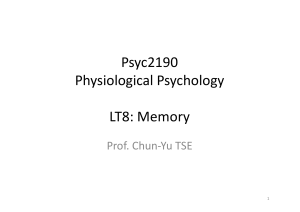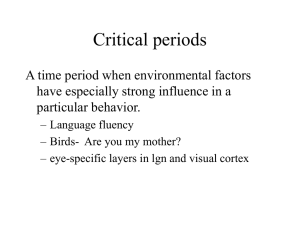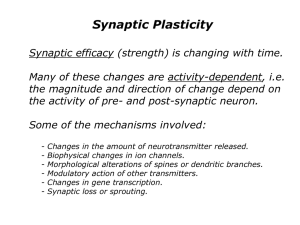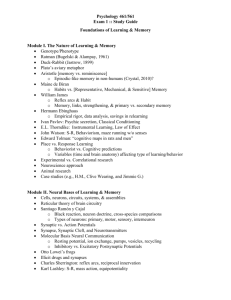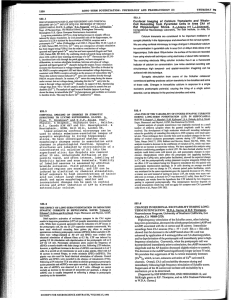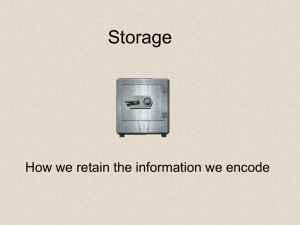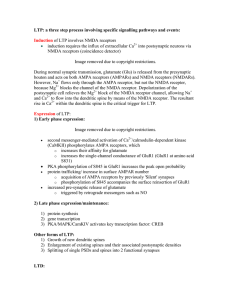APPROACHES TO THE BIOLOGY OF MEMORY Scale of analysis: Focus of Analysis:
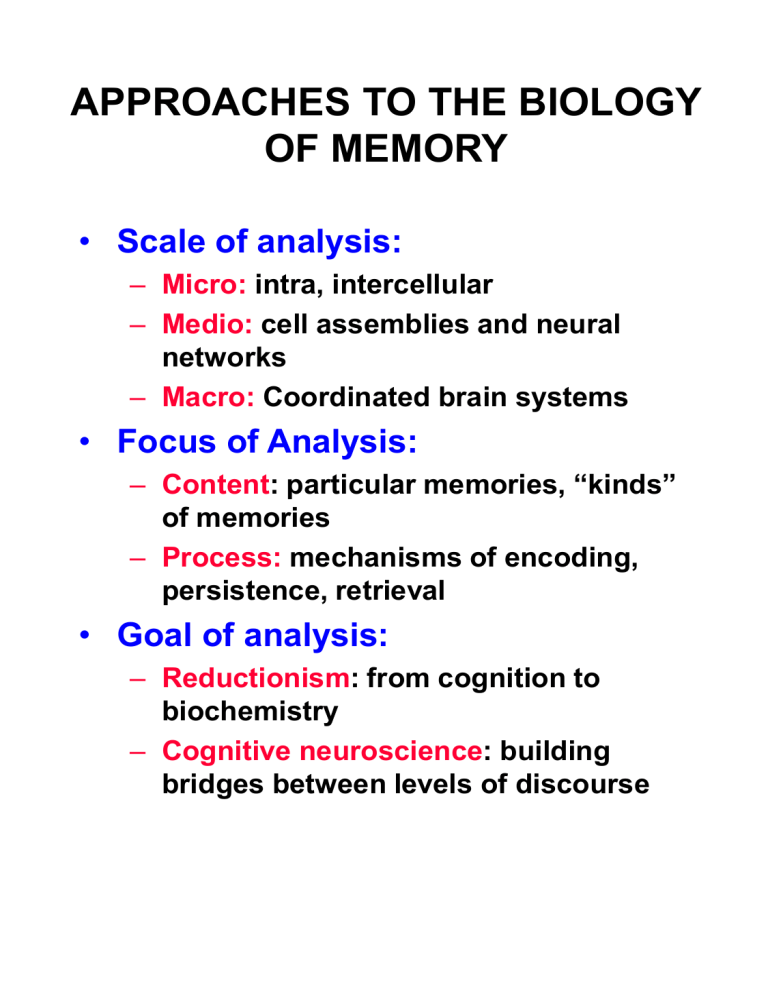
APPROACHES TO THE BIOLOGY
OF MEMORY
• Scale of analysis:
– Micro: intra, intercellular
– Medio: cell assemblies and neural networks
– Macro: Coordinated brain systems
• Focus of Analysis:
– Content : particular memories, “kinds” of memories
– Process: mechanisms of encoding, persistence, retrieval
• Goal of analysis:
– Reductionism : from cognition to biochemistry
– Cognitive neuroscience : building bridges between levels of discourse
THE NEURONAL BASES OF
MEMORY
• A (re)view of neuronal conduction
• Potential memory mechanisms
– More (or fewer) neurons
– More (or fewer) synapses
– Efficiency of synapses
– Surface area of synapses
– Changes in other cell areas
Activation and Alteration of
Synapses
• Kandel’s work with Aplysia (Sea Hare)
– Habituation of gill-withdrawal reflex
• Presynaptic membrane is altered
• Fewer calcium ions
• Fewer vesicles move to cleft
• Less neurotransmitter is released
• Smaller postsynaptic potential shift
• Smaller motor nerve stimulation
• Diminished gill withdrawal
LONG-TERM POTENTIATION
• How LTP is produced
– 100 Hz stimulation of synapse
– Increases response to later stimulation
– Can last hours in vitro, days in vivo
– Seen most readily in hippocampus
• One scenario of how it works
– Postsynaptic membrane changes
– Increase in calcium ions (Ca+)
– More glutamate receptors activated
(N-methyl-D-aspartate, or NMDA)
– Glutamate uptake increases
– Increases postsynaptic activity
– Requires co-occurrence of neurotransmitter & depolarization
LTP Changes Dendritic
Morphology
Images of Dendritic Changes after LTP
• Genetically enhancing LTP
– NMDA receptors have two subunit types
– NR2B gives more sustained “current”
– Proportion of NR2B greater in young mice
– Genetically enhancing NR2B ratio
• Increases NMDA-mediated current
• Gives greater LTP in vitro, vivo
• Improves learning and retention on a wide range of tasks (Tang, et al., 1999)
LONG-TERM DEPRESSION (!)
– Weak, slow stimulation reduces
EPSP
– Distinct from “decay” of LTP
– Effect is dependent on “history”
– Same stimulus can give LTP or
LTD depending on timing
– 5-15 ms prior to PSAP > LTP
– 5-15 ms after PSAP > LTD
– A “negative feedback” mechanism for continued plasticity?
• cyclic AMP-response element binding protein (CREB) and LTP
– Repeated LTP stimulation
– Synthesis of CREB via genetic activation of postsynaptic nucleus
– Thought to be (one) basis of longer-term memory and retention
• Other neuronal changes with learning
– Enriched, complex environments give increased synaptic counts
– Some recent evidence for increases in neuron population with learning
• The outlook
– Rapid progress
– Proliferation of types and loci of LTP and of “memory molecules”
FRONTIERS IN THE
MICROBIOLOGY OF MEMORY
• The search for “memory drugs”
– Potential sites of action
– Interesting and uninteresting effects
– Current evidence is modest at best
• Consolidation and the hippocampus
– Animal models of consolidation
– The problem of time-course
– Correlations with independence of hippocampal function
• Reconsolidation
– Protein-synthesis blocker (anisomysin) after ”retrieval” creates amnesia (Nader,
Schafe & LeDoux, 2000)
– “The notion that recurrent vulnerability windows exist in LTM has remarkable practical potential, for example the deletion of anguishing post-traumatic memories by postretrieval intervention. Some psychotherapists, of course might claim that this is exactly what they are trying to do already” (Dudai, 2002)
• Gron, et al. (2005)
– Donepizil (Acetylcholine esterase inhibitor, used for Alzheimer’s)
– 30 days of treatment in healthy adults
– Battery of standard clinical tests of cognition, including memory, pre and post
– Drug vs. placebo seen only in episodic memory tests, visual and verbal:


